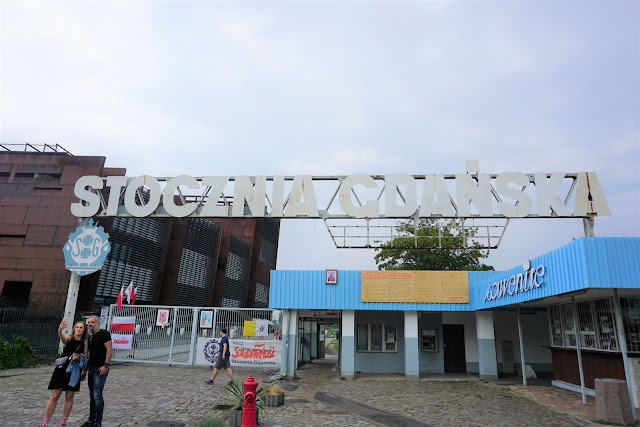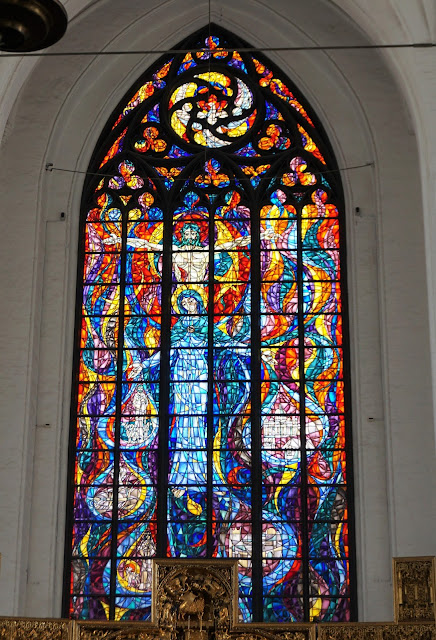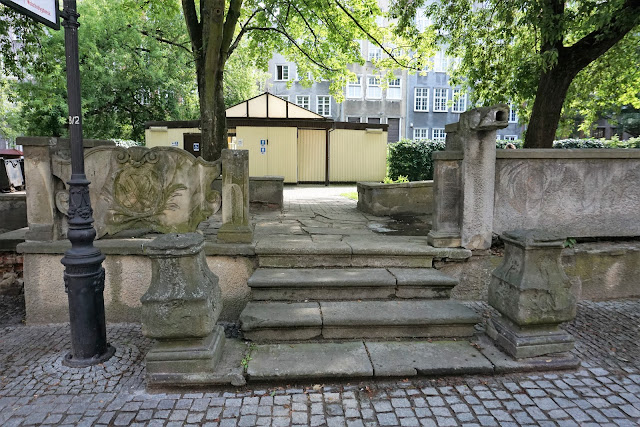June 21, 2019
There is a lot to see in Gdansk, and a good way to see it is by hiring a private tour guide. Our guide, Klaudia, was excellent.
The first place she took us was to Solidarity Square, the site where 45 striking shipyard workers who were protesting the communist regime were killed in 1970. At the center of the square is the Monument to the Fallen Shipyard Workers of 1970, also known as the Three Crosses Monument, which was erected 1980 next to entrance of what was then called the Lenin Shipyard. It was the first monument in the world erected in a Communist country to recognize victims of Communist oppression.
Three 138-foot steel crosses, each weighing 36 tons, stand on the spot where the first three victims of the riots were killed. The crosses represent the suffering and sacrifice of those first three victims, subsequent victims, and all of the protestors. The crosses are topped by anchors, symbols of the shipping industry. Bas reliefs of the dock workers adorn the bottom of the shafts.
Stockznia Gdankska = Gdansk shipyard:
I loved these inset sculptures showing different aspects of/events related to the Solidarity movement:
Other monuments around the square dedicated to the victims of totalitarianism were very poignant.
Our next stop was St. Mary's Church, one of the largest brick churches in the world, and overall one of the largest of any type north of the Alps. Originally constructed in the 14th and 15th centuries, it has been used for both Catholic and Lutheran services, sometimes simultaneously!
Because it is surrounded by buildings, I couldn't get a good photo of it, but this borrowed photo (from here) gives an idea of its massive size:
The tower is 256 feet tall, and the soaring vaulted Gothic ceilings of the interior remind me of the psalm, "What is man, that thou art mindful of him?"
On the other hand, just standing in this pulpit would make me feel like a king. No wonder the religious leaders of those days exercised so much power.
This church almost made it through World War II without serious damage, but when Russia stormed the city in March 1945, the church was set on fire. The wooden roof was burned, most of the ceiling collapsed, fourteen of the vaults collapsed, and the stained glass windows were destroyed. The gravestone slabs on the floors were torn up, supposedly by Russian soldiers looting the bodies buried below. Luckily, many of the priceless artworks had been removed and hidden in nearby villages.
Reconstruction began in 1946 and the church was reconsecrated in 1955.
The main altar is backed by this stunning modern stained glass window depicting the crucifixion of Christ with Mary in the foreground:
A 16-century gold-covered screen in front of the window depicts Mary about to be crowned the Queen of Heaven:
Together, the window and screen are stunning:
One unique feature in this cathedral is the crypt of Pawel Adamowicz, the beloved mayor of Gdansk since 1998. Just a few months before our visit, he was stabbed at a charity event and died the next day. His assassin was a man who had recently been released from prison. Lech Walesa attended his funeral, which was held in this cathedral. After the services, he was cremated and his ashes are in this vault:
St. Mary's also has a copy of Poland's famous Black Madonna icon, which we would visit later in Czestochowa:
At one time, the walls of the cathedral were covered with frescoes, but most of them were destroyed or covered. A few still remain:
I was happy to see a tour group here. It seems to me that tourists are becoming less interested in visiting churches. An interest in this cathedral from outsiders will help to preserve its treasures. By the way, did you notice the iron grill work surrounding this icon and the previous Black Madonna? Very unique.
I was also intrigued by this much more modern painting of a woman pierced by numerous arrows, a lot like St. Sebastian. This is St. Dorothy of Montau (1397-1394), a German Hermitess, painted in 2017 by Krzysztof Izdebski-Cruz:
Back on our walk, we passed the Great Armoury, aka Old Arsenal, built in 1600-1609. It was in use as an arsenal until the 1800s and is considered the finest example of Renaissance architecture in Gdansk. Like so many of Gdansk's treasures, the Armoury was badly damaged in World War II and had to be completely rebuilt. These days it is used as an art gallery.
This pedestrian area, one of my favorite places in Gdansk, is known as "Long Market." It was part of the city planning in the 13th century and was the main thoroughfare through the city
That tall, skinny spire at the end of the street is the 16th century Town Hall:
The courtyard around the Town Hall is now used as a gallery by artists trying sell their paintings:
Neptune's Fountain was constructed in 1617:
We stopped for lunch and ordered four kinds of pierogi. I also had a bowl of fermented rye soup, and Bob had a bowl of mushroom soup. Amazing.
The building below, Artus Court (Artus = the medieval King Arthur), originally built in about 1350 but then reconstructed in the early 17th century, used to be a merchant meeting place, but today it is used as a history museum:
This doesn't look very Dutch, at least to me, but the buildings flanking it do:
Everywhere we looked, there was more stunning architecture:
. . . a cuckoo clock and a beetle:
. . . a cat and a flowerpot:
Some of what was salvaged from the bombed out city after the war was used to make these elevated parks. The worn appearance of the materials stands out in this largely newly built city:
The final place Klaudia took us was to her mother's apartment. She said she likes to take tourists there. Her 82-year-old mother enjoys the visit, and it gives tourists a glimpse into real-life apartment living in Gdansk. She had a nice one-bedroom apartment with a small kitchen and a relatively large living room. Her mother didn't speak any Polish, so Klaudia translated for us. In any case, the language of hosptitality and friendliness is universal. I wish I would have taken a few pictures, but it seemed a little invasive of the kind woman's privacy.
And that was it for Gdansk, a city I would LOVE to return to.
Klaudia dropped us off at the airport
So many good food choices! Too bad we didn't bring some home.
I also wish I had purchased a Solidarity memento. Lech Walesa--what a guy!
We highly recommend Klaudia as a Gdansk tour guide. You can find her through info@easygdansktours.com.





































































I loved Gdansk. Not for its historical value, but just as it was. Beautiful architecture, nice shops, enticing restaurants and just a nice vibe. I enjoyed the walk we did on our own there as much as any walk I can recall. I thought the cross memorial in front of the shipyard was one of the more powerful memorials I've ever seen. And yes, Klaudia was a guide that is worth seeking out.
ReplyDelete